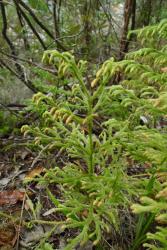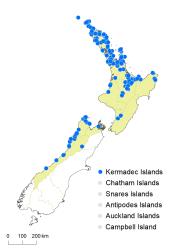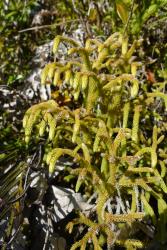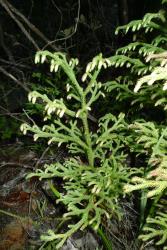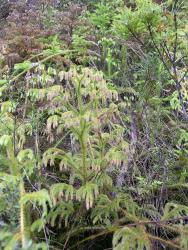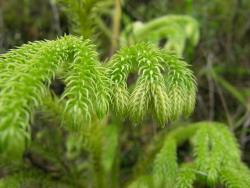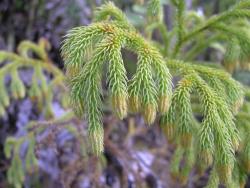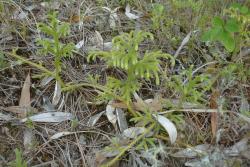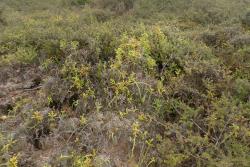- ≡ Lycopodium cernuum L., Sp. Pl. 1103 (1753)
- ≡ Lepidotis cernua (L.) P.Beauv., Prodr. Aethéogam. 108 (1805)
- ≡ Palhinhaea cernua (L.) Vasc. & Franco, Bol. Soc. Brot. Ser. 2 41: 25 (1967)
- = Lycopodium polycephalum Colenso, Trans. & Proc. New Zealand Inst. 27: 401 (1895)
- ≡ Palhinhaea polycephala (Colenso) Holub, Folia Geobot. Phytotax. 20: 79 (1985)
Horizontal stems dichotomously branching, looping across the ground, rooting at intervals 40–670 mm apart (in herbarium specimens), 2–6 mm diameter; leaves widely spaced, incurved, linear, adnate. Aerial stems arising between rooting points, usually one main stem per loop, erect, branching monopodial, glabrous or rarely hairy; longest fertile aerial branching system 50–620 mm tall, 30–270 mm wide; unbranched portion of stem 10–140 mm long, branched portion 40–600 mm long. Branches curling downwards at apices. Sterile leaves monomorphic, spirally arranged or in rough whorls, decreasing in size slightly towards the apex, incurved, linear to narrowly triangular, apices acuminate, margins entire, bases adnate, 3–8 mm long, 0.4–0.8 mm wide, grey-green. Sporophylls appressed when young, somewhat spreading at maturity, ovate, long acuminate, margins ciliate, bases adnate or subpeltate, 1.6–3.0 mm long, 0.7–1.2 mm wide, aggregated into strobili. Strobili solitary, terminal on branches, pendent or inclined downwards, sessile, yellow to yellow-brown, 4–20 mm long, 3–6 mm wide.
Note: measurements given above are from herbarium specimens. Longer aerial stems, documented photographically, are known to occur in the wild up to 1800 mm tall.
Lycopodiella cernua is easily recognised by its looping horizontal stems; its dendroid aerial stems that arise on the looping stems between rooting points; its ultimate branches, which tend to curl downwards; and its pendent strobili.
North Island: Northland, Auckland, Volcanic Plateau, Gisborne, Taranaki, Southern North Island.
South Island: Western Nelson, Sounds-Nelson, Westland.
Kermadec Islands, Three Kings Islands.
Altitudinal range: 0–1050 m.
Lycopodiella cernua occurs on Raoul and Macauley Islands in the Kermadec Islands, and in coastal and lowland areas of the North Island from Kaitāia to Mt Tongariro, extending locally into montane regions. There are outlying populations further south around Palmerston North. The species grows from sea level up to 1050 m on Mt Tarawera. In the South Island it extends from north-west Nelson along the west coast to Bruce Bay in south Westland, growing from near sea level, up to 300 m near Denniston. There is an isolated population at Tennyson Inlet in the Marlborough Sounds.
Also widespread in tropical and subtropical regions of the Americas, Africa, Europe, Asia, Australia (Western Australia, Northern Territory, Queensland, New South Wales), Norfolk Island, Lord Howe Island, and most islands of the South Pacific.
Lycopodiella cernua grows terrestrially on track or roadside banks, on road cuttings and cliffs, on clay soils, on scoria, in gumland, on stabilised dunes, under mānuka, kānuka or Dracophyllum scrub, occasionally under rātā forest, and most abundantly in thermal areas on the edges of steam vents, hot springs and streams or steaming lakes.
2n = c. 200 (de Lange et al. 2004).
The combinations Lycopodium cernuum var. curvatum (Sw.) Nessel, Bärlappgewächse 354 (1939) and L. cernuum var. vulcanicum (Blume) Nessel, Bärlappgewächse 354 (1939), based in part on New Zealand material, are almost certainly misidentifications. The types of L. curvatum Sw. and L. vulcanicum Blume are from Jamaica and Java, respectively. Nessel (1939) made almost 40 spurious varieties and forms in L. cernuum which, although unhelpful nomenclaturally, did indicate the range of morphological variation in this species.
Burnard et al. (2016) detected three different haplotypes in populations of Lycopodiella cernua from New Zealand, New Caledonia, Fiji, Malaysia, Japan and USA. The New Zealand specimens were identical to that from Japan but different to those from elsewhere. Burnard et al. (2016) suggested that different lineages may be adapted to temperate and tropical habitats. The species also exhibits morphological variation in the hairiness of the branches (Zhang & Iwatsuki 2013) and needs further investigation.



